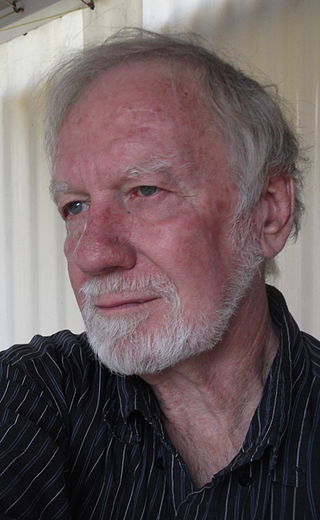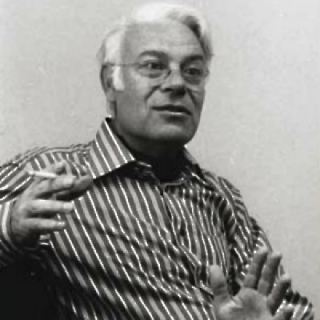
Wendy Sharpe is an Australian artist who lives and works in Sydney and Paris. She has held over 70 solo exhibitions nationally and internationally, been awarded many national awards and artist residencies for her work, and was an official Australian War Artist to East Timor in 1999–2000.

Joseph Stanislaus Ostoja-Kotkowski AM, FRSA was best known for his ground-breaking work in chromasonics, laser kinetics and 'sound and image' productions. He earned recognition in Australia and overseas for his pioneering work in laser sound and image technology. His work included painting, photography, film-making, theatre design, fabric design, murals, kinetic and static sculpture, stained glass, vitreous enamel murals, op-collages, computer graphics, and laser art. Ostoja flourished between 1940 and 1994.
Herbert Flugelman, usually known as Bert, was a prominent Australian visual artist, primarily a sculptor, who had many of his works publicly displayed. He is known for his stainless steel geometric public sculptures. Among his best-known works are the "Mall's Balls" in Adelaide, and "the Silver Shish Kebab" in Sydney.
Asher Bilu is an Australian artist who creates paintings, sculptures and installations. He has also contributed to several films by Director Paul Cox as production designer. He was born in Israel, and began his career as an artist soon after arriving in Australia in 1956. From the start, his art has been abstract, with particular emphasis on technological experimentation. His technique changes as he investigates the use of new media, but his work always reflects his fascination with light, and his love of music and science, especially cosmology.
Elisabeth Cummings is an Australian artist known for her large abstract paintings and printmaking. She has won numerous awards including Fleurieu Art Prize, The Portia Geach Portrait Prize, The Mosman Art Prize, and The Tattersalls Art Prize. Her work is owned in permanent collections across Australia including Artbank, The Queensland Art Gallery, The Gold Coast City Art Gallery and the Art Gallery of New South Wales. She is notable for receiving recognition later in her career, considered by the Australian Art Collector as one of the 50 most collectible Australian Artists.

Desiderius Orban, was a renowned Hungarian painter, printmaker and teacher, who, after emigrating to Australia in 1939 when in his mid-50s, also made an illustrious career in that country.

Hossein Valamanesh was an Iranian-Australian contemporary artist who lived and worked in Adelaide, South Australia. He worked in mixed media, printmaking, installations, and sculpture. He often collaborated with his wife, Angela Valamanesh.
Australian feminist art timeline lists exhibitions, artists, artworks and milestones that have contributed to discussion and development of feminist art in Australia. The timeline focuses on the impact of feminism on Australian contemporary art. It was initiated by Daine Singer for The View From Here: 19 Perspectives on Feminism, an exhibition and publishing project held at West Space as part of the 2010 Next Wave Festival.
Margel Ina Harris Hinder was an Australian-American modernist sculptor, noted for her kinetic and public sculptural works. Her sculptures are found outside the Australian Reserve Bank building in Martin Place, Sydney, in a memorial in Newcastle, New South Wales, and in Canberra, ACT. Her work is held in several Australian public collections.

Richard R Cornish is an Australian art theoretician and practitioner. He is an artist, writer, poet, teacher and left-wing political activist. He has won many prizes for his art and draughtsmanship and was a student at the National Art School.

Udo Sellbach (1927–2006) was a German-Australian visual artist and educator whose work focused primarily around his printmaking practice.

Linde Ivimey is an Australian sculptor.
Debra Phillips is an Australian artist. Her main practice is photography but she also works across other forms such as sculpture and moving image. She has been an exhibiting artist since the 1980s, is a part of many collections, and has won multiple awards for her work. Phillips resides in Sydney and is a senior lecturer at The College of Fine Arts, University of New South Wales.
Robert Owen is an Australian artist and curator. He lives and works in Melbourne, Australia.
Alex Seton is an Australian artist, known for his contemporary use of marble carving. He also works in sculpture, photography, video and installation.
Mazie Karen Turner was an artist from Newcastle, Australia. She worked in photography, sculpture and painting.
John Neylon is a South Australian arts writer and arts educator as well as being an art critic, curator, painter, and printmaker. He is an art critic for The Adelaide Review, an author for Wakefield Press, and a lecturer in art history at Adelaide Central School of Art.
Leonie Reisberg is an Australian photographer.

Ewa Pachucka was a Polish-Australian sculptor.
Hertha Kluge-Pott is a German-born Australian printmaker based in Melbourne.








